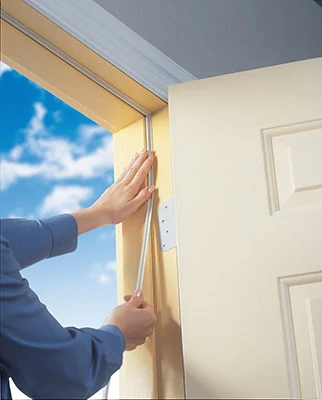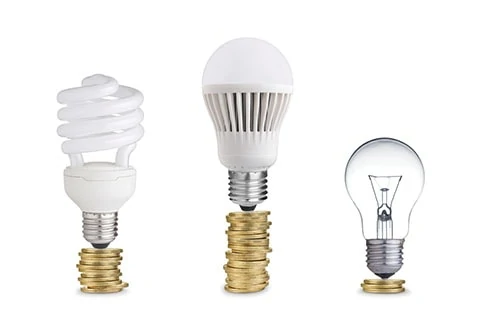Do Your Part (the Lazy Way)
Power bills giving you the blues? That’s a common problem when the weather is blazing hot, the air conditioner is running full-blast, and then the mailman drops off that dreaded envelope. It’s also common in the dead of winter, when the heater is cranked up to eleven.
Some energy-saving upgrades take a lot of time, effort and/or money, like window replacements, adding new insulation, replacing inefficient appliances.
But some steps are easy. For the lazy DIY’er, here’s a list of simple tactics to save energy around the home—so simple you won’t even break a sweat.
Rethink Your Light Bulbs
Compared to the old-fashioned incandescent bulbs, new CFL or LED bulbs use only a fraction of the electricity. They produce the same brightness (lumens) while using fewer watts, plus they last longer for less frequent bulb replacements. CFL or LED bulbs are not all the same, however, when it comes to performance. Bulbs certified with the U.S. DOE’s Energy Star label indicate they’ve undergone extensive testing. An Energy Star-certified light bulb uses about 70 to 90 percent less energy and lasts 10-25 times longer. Plus, most Energy Star LED bulbs are dimmable (check the package for more information).
Use your Ceiling Fan
Remember that a ceiling fan uses less energy than your air-conditioner, so use the fan to lower your energy bill and still stay comfortable. Just be sure to turn it off when you leave the room.
One often-overlooked aspect of a ceiling fan is its Reverse feature. Your fan probably has a directional switch on the motor, so reverse your fan in winter to produce a gentle updraft, forcing warm air that hovers near the ceiling down into the living space.
Alter your Laundry Habits
When it comes to the temperature setting on a washing machine, many people simply set it and forget it. But water heating actually makes up about 90 percent of the energy it takes to operate a clothes washer. If you use the cold water setting on your clothes washer, that’s money in the bank (yours). Specially formulated laundry detergents are available for cold water washing.
Here’s a few more simple laundry tips: Wash fuller loads so that you wash fewer loads. On occasions when you need to run a small load, set the machine to use a lower water level. Also, consider using longer spin times in the washer to reduce the amount of drying energy needed.
Speaking of the dryer, it seems that for most homeowners the clothesline has gone the way of the dodo. According to the Department of Energy, more than 80 percent of US homes now have a clothes dryer, accounting for 6 percent of residential electricity consumption.
Cleaning the lint trap after each use is one of the easiest things you can do to improve air circulation and increase the efficiency of the dryer. Also, consider using a lower heat setting to conserve energy. Use the moisture sensor option to avoid over-drying clothes. And don’t overstuff the dryer because it causes longer drying cycles.
Replace your HVAC Filter (Again)

Practically every home energy-saving article you’ll read will mention the importance of changing your air filter regularly. So why mention it here? Because people still forget the filter because it’s not readily visible. And for most people, out of sight is out of mind. I’m a prime example; I write about home improvement routinely and forget to change my system’s filter routinely.
If the filter looks dirty after a month, change it, especially during heavy use months (winter and summer). At a minimum, change the filter every three months. A dirty filter will slow down air flow and make the system work harder (and use more electricity) to keep you warm or cool. A clean filter will also prevent dust and dirt from building up in the system, which can lead to expensive maintenance and/or early system failure.
Adjust your Water Temperature
If your home has a water heater with a tank, set the heater thermostat to 120 degrees F or lower. This will reduce the amount of energy it takes to produce and maintain your hot water by not overheating it. When you’re away on vacation, turn off electric heaters and turn down gas heaters so you’re not heating water that no one is using. The average household spends more than $250 per year on water heating, which makes it the second largest home-energy expenditure behind heating and cooling.
Tool-free Weather Seals
Let’s say you’ve sworn off manual labor for the weekend but you’re annoyed by a drafty window. It doesn’t get much easier than slapping up some self-stick weather-stripping. The stuff is sold in rolls, so the only tool you’ll need is a pair of scissors to snip it to length. You’ll find adhesive tapes made of vinyl foam, rubber foam, and EPDM rubber in a number of profiles. Thickness typically ranges from 1/4 to 1 inch.

Does your home need to be caulked, but you hate the sticky, gooey application process? I don’t blame you. One option is rope caulking which has a dry, clay-like consistency similar to plumber’s putty, and you press it into cracks or gaps up to 1/4 inch, shaping the bead with your fingertips. Rope caulk is easy to remove, and no caulk gun or cleanup is required.
Sealing air gaps around doors and windows can save you 10 to 15 percent on your energy bills.




